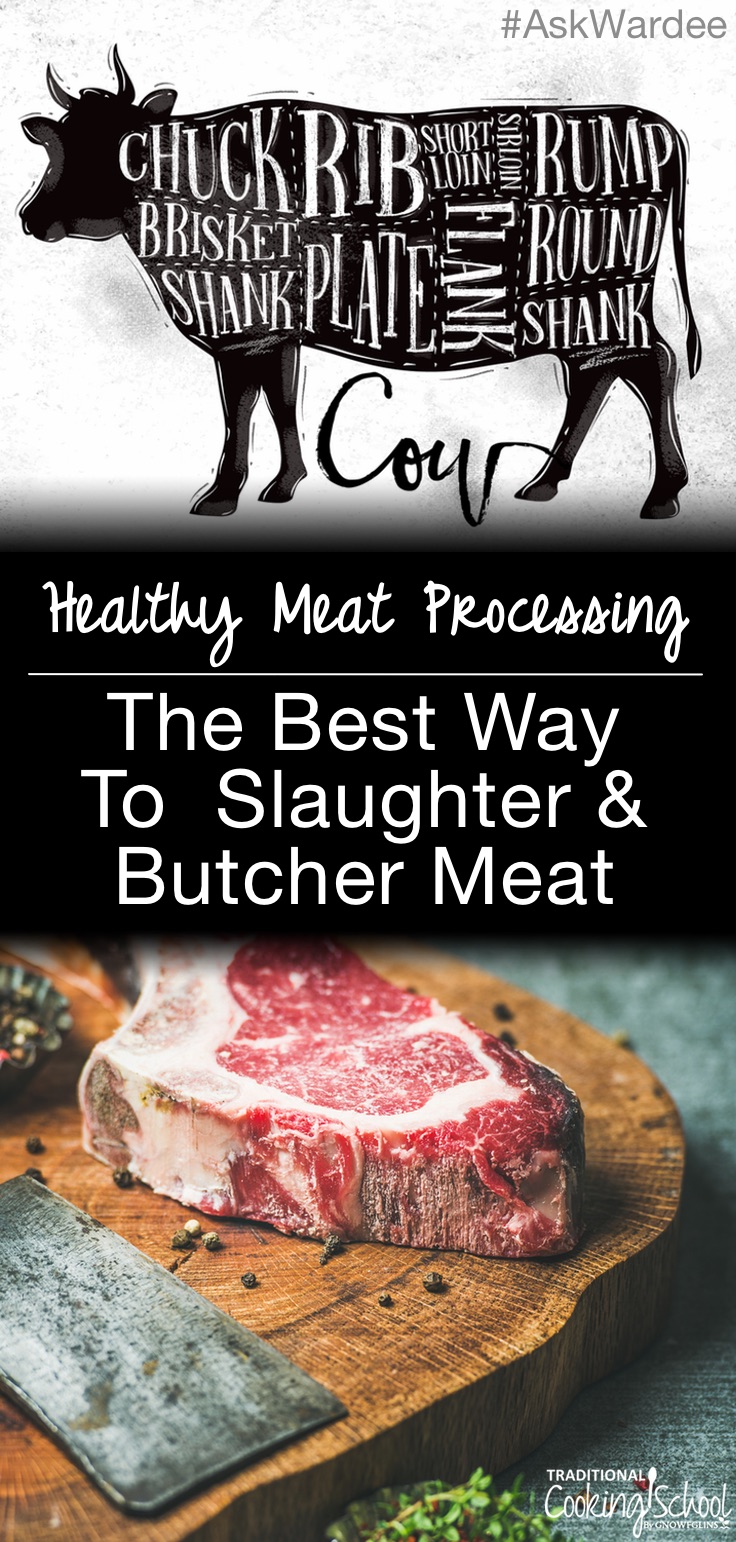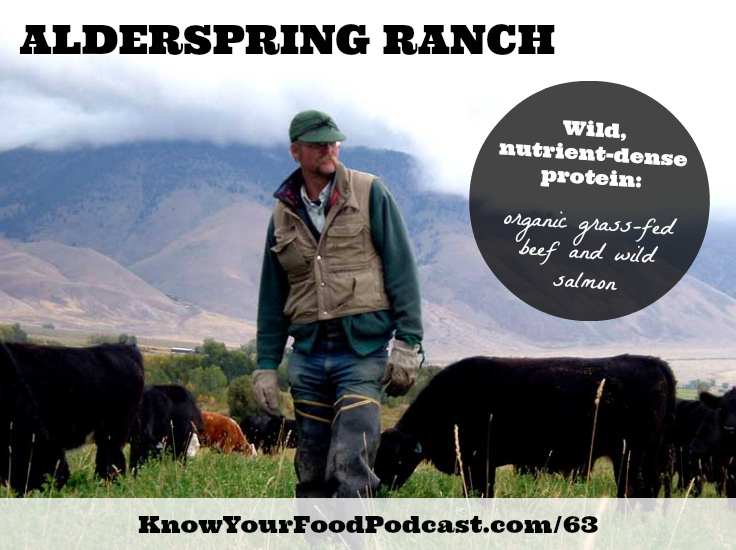
How an animal is slaughtered and processed is just as important as its being pastured or grass-fed!
Seriously, if care isn’t taken with processing (aging, packaging, tenderizing, etc.)…
…you could end up eating the worst-tasting, mushiest meat ever.
On the other hand, if it’s done well… you’ll feel peace about the way the animal ended its life, and your meat will turn out so flavorful and tender!
Yes, the way an animal is butchered makes a huge difference in how the meat turns out!
So on today’s #AskWardee, I’m talking about healthy meat processing. Here’s what you must look for when slaughtering and processing your pastured meats, or sourcing meats locally or online.
Subscribe to #AskWardee on iTunes, Stitcher, YouTube, or the Podcasts app.
The Question: The Best Way To Slaughter And Butcher Meat?
Natalie J. asks:
Hi, Wardee. I love your stuff, so thanks for sharing with us! My question is about sourcing my meat. I am concerned with how the animal is slaughtered and processed. I have read that they can be humanely handled and fed, but what about what happens before and during the processing?
My Answer
Natalie, you’re absolutely correct to look for healthfully raised meats. This past #AskWardee has all the scoop on that — The Difference Between Grain-Fed & Grass-Fed Meat {3 Reasons Grass-Fed Is Healthier!} #AskWardee 073.
Since we’re on the same page about that, let’s jump right in to what you want to look for in how your animal is slaughtered and processed.
By the way, though they might be implemented differently, the following standards are the same whether you’re slaughtering and processing meat yourself or having it done for you (like we did with our first home-grown beef).
So, here are four things to look for:
1. Stress-Free Slaughter
The animal shouldn’t be excited, panicked, or stressed when it’s put down. It should be in a peaceful environment. Animals are often moved to another location for slaughtering and shouldn’t be killed until they have adjusted to their new surroundings.
Not only is it unkind to mistreat animals with poor conditions, the meat will not be nearly as good.
The Complete Book Of Butchering, Smoking, Curing, And Sausage Making goes into great detail about how stress, temperature, and the animal’s health can affect the texture, pH, moisture, and color of meat.
The meat can end up dark, firm, or dry —OR— pale, mushy, and dry if the animal was under stress during slaughter. (The look and texture depends on what wasn’t done well during slaughtering.)
The bottom line? If the animal is happy, the meat turns out better. If the animal is stressed, the meat doesn’t turn out so good. (Plus, it’s just mean to the animal.)
Animals can be put down in multiple ways. The actual method (gun shot, throat slit, etc.) is not as important as whether or not the animal was stressed before or during slaughter.
P.S. Have you seen the movie Temple Grandin? A remarkable autistic woman, Temple Grandin introduced the world to the benefits of humane slaughter. I’m inspired to watch it again soon!
2. Look For Dry-Aged
When we lived in Indiana, we were so fortunate to live within an hour’s drive of This Old Farm in Colfax, Indiana. They processed the whole beef we purchased for two years straight. They are awesome!
Here’s what they say about dry-aging and why it’s superior to how conventional meats are processed (wet aging):
After slaughter, carcasses are split down the spinal column, washed down, tagged with all necessary information needed for 100% traceability, and then put into the cooler to dry-age.
Beef is typically dry-aged for 6 to 14 days after slaughter (4 to 7 days for pork, lamb, and goat).
Dry-aging is an important factor in getting the best quality of meat. During this process, enzymes in the meat change the muscle fibers, which makes the meat more tender, increases quality of taste and adds to the meat’s juiciness.
Most meat bought in the U.S is not aged at all, or sometimes wet-aged for a short time.
Wet-aging means that the primal cuts (chuck, rib, loin, or round) are wrapped in plastic and stored at cold, above-freezing temperatures.
Here at This Old Farm, all of our beef, pork and lamb are hung in our coolers at 34° to 40° F for optimal results. After dry-aging, meat is cut and packaged to order. —This Old Farm “What Is Dry Aging?”
Dry-aging is highly desirable to increase the flavor and tenderness of your meat. Look for a minimum of 7 days for beef — and bonus points if you get beef that’s been dry-aged for up to 21 days. 🙂
During this time, it’s important that conditions are sanitary and that air can circulate freely. The meat should be kept below 40° F, yet not allowed to freeze.
You will love the flavor and texture of your meat if it’s dry-aged. The longer it ages, the more benefits you’ll see.
So, seek out a butcher that offers dry-aging as you select a farm/processor for a quarter, half, or whole beef. And for pork, lamb, and goat, too!
3. The Packaging
The meat’s packaging will affect its taste and how long it lasts, especially in a freezer. (Packaging is less important than #1 and #2, however.)
We prefer vacuum-sealed packages (BPA and BPS-free) rather than the plastic bags or freezer paper that are often used.
Vacuum-sealed packages last longer and don’t get freezer burn — except when the vacuum seal is punctured (then it does no good). If a package gets punctured, eat that meat up first. 😉
4. What About Mechanical Tenderizing?
When you’re choosing your cuts (steaks, roasts, ground, etc.) the butcher might ask you if you want any of it tenderized. Here’s what Alderspring Ranch (premium grass-fed organic beef from Idaho) has to say about this:
This is more common than most people realize and involves stabbing the meat with narrow razors to tenderize it before packaging. We believe this introduces pathogens from the outside of the meat to the inside, and should not be needed if beef is produced correctly. Our growing and processing protocols are what make Alderspring beef tender, not mechanical tenderizing.
For this reason, our family turns down mechanical processing. And actually, we get all the less tender cuts turned into ground beef anyway. 🙂
~~~
These four things will help you ensure the best and healthiest outcome as you learn to process your own meat or search out locally raised meat.
What If You Can’t Find This In Your Area?
I recommend Alderspring Ranch for humanely slaughtered and dry aged beef! They’re in remote Idaho and ship across the U.S., and their beef is grass-fed, grass-finished, and certified organic.
Save $10! Our readers can save $10 on their first order by using coupon code TCSchool10 at checkout. Here’s more information.
The owner, Glenn Elzinga, was a guest on my old podcast — click here to listen in and learn more about their beef that’s raised on mineral-rich soils in places where few people have ever been!
Helpful Links:
- The Difference Between Grain-Fed & Grass-Fed Meat {3 Reasons Grass-Fed Is Healthier!} #AskWardee 073
- Butchering Our First Home-Grown Grass-Fed Beef
- Alderspring Ranch — online ordering of grass-fed beef from Idaho — save $10 on your first order!
- My podcast with guest Glenn Elzinga from Alderspring Ranch (KYF163)
- Free Traditional Cooking Video Series
Do you know about healthy meat processing? What do you look for when slaughtering and processing meat?
We only recommend products and services we wholeheartedly endorse. This post may contain special links through which we earn a small commission if you make a purchase (though your price is the same).



In a heading I saw Mullein mentioned I thought in relation to goat feed. I’m trying to get enough roughage for my goats to prevent them from eating my trees. Have tons of mullein seed heads. Will they eat it & will they digest it well enough so it won’t re-seed?
Hi, Kathryn,
That is a great question! I checked with Wardee and she is not sure if the mullein seeds will re-seed after the goats digest them. I wish I could be of more help.
~Peggy, TCS Customer Success Team
No matter how the animals to be slaughtered, slaughter is killing and killing is just a kind of cruelty
Hi Sarah,
We believe eating meat is essential to a healthy, nourishing diet. You can read more on that here: https://traditionalcookingschool.com/q-a/askwardee-011-do-you-need-to-eat-meat-to-be-healthy/
The only way to eat meat is to harvest or slaughter an animal and we believe there is a way to slaughter an animal that is respectful and low-stress.
~Danielle, TCS Customer Success Team